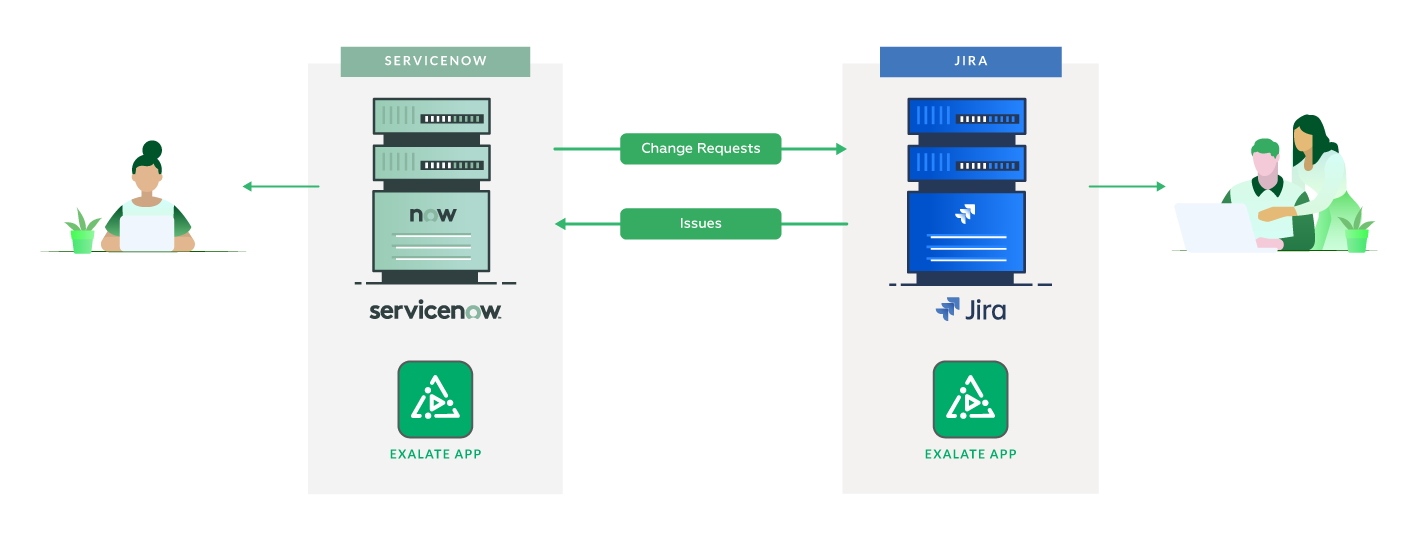
Use Case 1: Integrate with Customer Jira to Manage the Product Change Requests
The product team uses ServiceNow to manage development. They have the workflow specifically created for change request management. The customer uses Jira to report product changes and wants to be informed about updates on the submitted requests.
Data Exchanged between Jira and ServiceNow
- Number
- Short description
- Description
- Requested by
- Requested by date
- State
- Comments
- Type (issue type from Jira to change request type in ServiceNow)
- cmdb_ci - ID (system field which is important to define the workflow of the change request on the ServiceNow side)
Flow
The customer raises a product change request in Jira. This request is synchronized to ServiceNow as a change request. Exalate is used to inform about updates from the product team that works in ServiceNow to the customer side who uses Jira. Below you can find the workflow for this integration.
- The customer creates an issue with the change in Jira
- The issue is automatically synchronized to ServiceNow including the basic info listed below:
- Number
- Short description
- Description
- Requested by
- Requested by date
- Type
- A change request is created on the ServiceNow side with all the data received from Jira.
- Confirmation is sent back to Jira, including a link to the change request which was created in the previous step.
- The change request is assigned to a team based on the data initially received from Jira.
- This triggers the relevant workflow based on the change type and cmdb_ci fields.
- Comments are synchronized in order to communicate between customer and product teams. This helps to clarify all the details.
- The status change on the ServiceNow side is synced to Jira to inform the progress of the change request.
- Sending the state change from Jira to ServiceNow is limited. The customer is not interested in the internal processes within the product team. Therefore you may send only the selected statuses such as Implement and Closed.
Note: The setup and flow must be aligned between sides before the implementation. The process and steps must be clear for the teams at both ends.
Use Case 2: Integrate your Jira with Customer ServiceNow to Manage Change Requests
The customer raises a change request in the ServiceNow instance. Then the request is synchronized to Jira, where the product team manages the customer's project. The main goal is to inform the customer about the status of their request and keep workflows on both ends as they are.
Data Exchanged between Jira and ServiceNow
- Number
- Short description
- Description
- Requested by
- Requested by date
- State
- Comments
- Type(issue type from Jira to change request type in ServiceNow)
- cmdb_ci - system field which is important to define the workflow of the change request on the ServiceNow side
Flow
- The customer creates a change request in ServiceNow.
- Then it is synchronized to Jira, where the development team manages the customer's project.
- An issue is created in Jira.
- Confirmation is sent to the ServiceNow side with a reference to the Jira issue. The reference is stored in the correlation_id field on the ServiceNow side.
- Comments are synchronized to communicate between teams.
- The status change is synchronized from Jira to ServiceNow to inform that the change request has been implemented.
- The state from ServiceNow is synced to Jira with conditions: the customer approves the implemented change. Alternatively, the state from ServiceNow may not be synced at all.
Note: The setup and flow must be aligned between sides before the implementation. The process and steps must be clear for the teams at both ends.
Use case 3: Integrate ServiceNow Instance with Jira to Distribute Change Tasks
An internal support team works in ServiceNow and uses change requests and change tasks to delegate some specific tasks to the dedicated teams. One of the teams works in Jira. The workflow on the support team on the ServiceNow side is configured to distribute change tasks automatically between dedicated teams. The development team uses Jira to manage the project. As a project manager in the support team, you need to be informed about the progress of development tasks since you need to inform users about the requested change.
Data Exchanged between Jira and ServiceNow
- Number
- Short description
- Description
- Description of type of change task
- Requested by
- Requested by date
- State
- Comments
- Type(issue type from Jira to change request type in ServiceNow)
- cmdb_ci - system field which is important to define the workflow of the change request on the ServiceNow side
Flow
- An internal support request is created in ServiceNow as a change request.
- Based on this request a support engineer creates change tasks for dedicated teams.
- The development task is automatically synchronized to Jira according to the workflow on the ServiceNow side.
- A new issue is created in Jira.
- The confirmation is sent back to ServiceNow with the required information:
- Jira issue ID reference stored in correlation_id of a change task
- Jira project name stored in correlation_display of a change task
- Comments are synchronized to communicate between teams.
- The status change is synchronized from Jira to ServiceNow to inform about the planned start/end date.
- Once the Jira issue is closed, the state of the change task is automatically changed to Closed on the ServiceNow side.
- The change request workflow is progressing to inform the customer about the change.